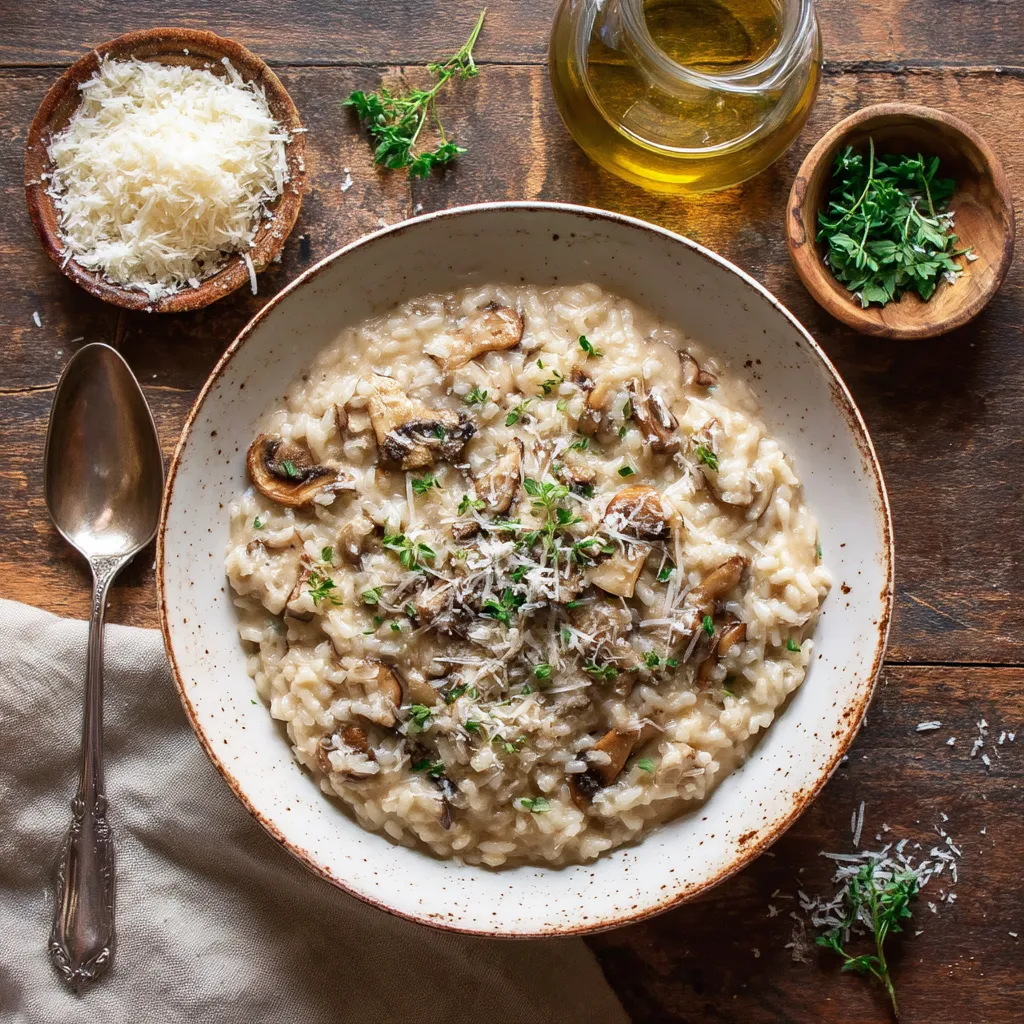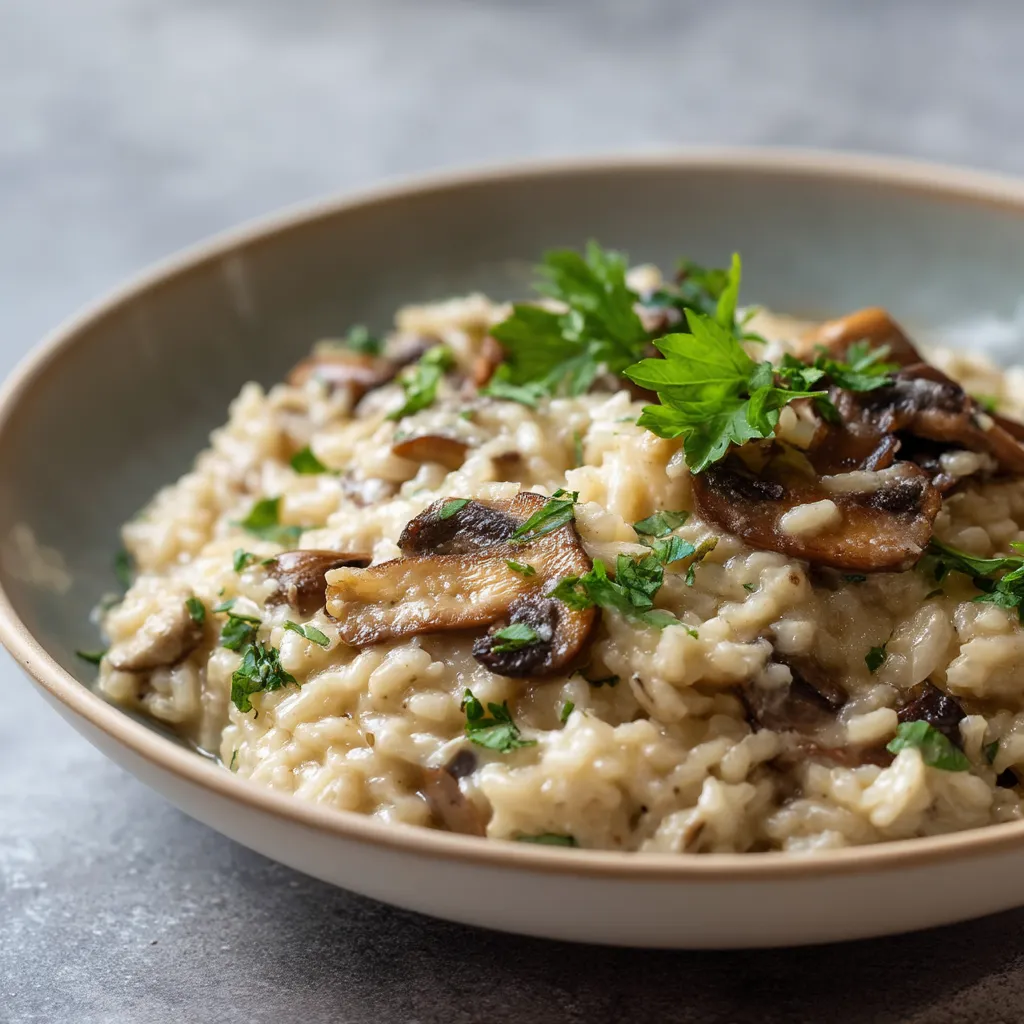 Mark
Mark
This creamy mushroom risotto transforms humble ingredients into a restaurant-worthy dish that will make your kitchen smell like an Italian trattoria. The slow-cooking process yields perfectly tender rice swimming in a velvety sauce studded with golden mushrooms. Though it requires some patience at the stove, the result is well worth the effort.
My first attempt at risotto years ago was a complete disaster a gluey mess that stuck to the spoon. After much practice and learning the secrets to proper risotto technique, this version has become my signature dish that friends specifically request when they visit.
Ingredients
- Cremini or mixed mushrooms: Provide earthy depth and meaty texture. Look for firm mushrooms with tight caps and no slimy spots
- Arborio rice: With its high starch content creates that signature creamy texture. Never rinse arborio rice before cooking
- Dry white wine: Adds acidity and complexity. Use something you would drink. Pinot Grigio or Sauvignon Blanc work beautifully
- Warm vegetable broth: Is gradually absorbed creating the perfect consistency. Homemade broth elevates the flavor substantially
- Parmesan cheese: Must be freshly grated from a block, not pre grated. The rind adds tremendous flavor if added during cooking
- Butter: Creates silky richness. European style butter with higher fat content makes a noticeable difference
Step-by-Step Instructions
- Sauté the Aromatics:
- Heat olive oil and butter until the butter foams slightly. Add onions and cook for a full 5 minutes until they become translucent but not browned. Stir occasionally to prevent burning. The slow cooking develops sweetness that forms the flavor foundation.
- Cook the Mushrooms:
- Add garlic and stir for just 30 seconds until fragrant before adding mushrooms. Do not overcrowd the pan or the mushrooms will steam rather than brown. Cook patiently until they release their moisture and then begin to caramelize around the edges. This concentrates their flavor dramatically.
- Toast the Rice:
- Add arborio rice to the pan and stir constantly for 1 to 2 minutes. You should hear a subtle clicking sound as the rice grains knock against each other. This step seals the exterior of each grain while keeping the center firm which gives risotto its distinctive texture.
- Deglaze with Wine:
- Pour in wine and you will hear a satisfying sizzle. Stir constantly until completely absorbed which takes about 2 minutes. The alcohol cooks off leaving behind complex flavor and acidity that balances the richness to come.
- Gradually Add Broth:
- Begin the meditative process of adding warm broth one ladle at a time. Keep the risotto at a gentle simmer not a rolling boil. Stir frequently but not frantically. The rice releases starch slowly creating the creamy sauce. This should take about 20 minutes total.
- Finish with Fat and Flavor:
- Remove from heat before adding cheese and butter. The residual warmth will melt them gently without breaking the emulsion. Let the risotto rest briefly covered to set the texture. A proper risotto should slowly spread when served rather than stand in a mound.

The mushroom selection makes all the difference in this dish. I once splurged on a mixture of chanterelles morels and porcini from a local forager and the result was transcendent. My partner who claimed to dislike mushrooms became an instant convert and now requests this dish on special occasions.
The Secret to Perfect Texture
The most common risotto mistake is overcooking. The finished rice should be tender but still have a slight resistance at the center what Italians call al dente. If your risotto becomes too thick simply stir in a splash more warm broth to loosen it. The consistency should be flowing but not soupy similar to loose oatmeal that gradually spreads when plated.
Mushroom Varieties to Try
Experiment beyond basic button mushrooms to discover new dimensions of flavor. Shiitake brings a meaty umami quality while oyster mushrooms offer delicate sweetness. For special occasions dried porcini soaked in hot water provides an intensely concentrated broth that can replace some of the vegetable stock. The soaking liquid becomes a powerful flavor booster. Even a small amount of reconstituted dried mushrooms mixed with fresh varieties creates remarkable depth.
Making Ahead and Storage
Risotto is notoriously best served immediately but reality sometimes requires compromise. If needed prepare it until almost done with a slightly firmer texture then cool quickly. When ready to serve reheat gently with additional warm broth stirring constantly. Add the final butter and cheese only after reheating. Leftovers will thicken considerably in the refrigerator for up to three days. Transform them into risotto cakes by forming into patties coating with breadcrumbs and shallow frying until golden.
Serving Suggestions
Serve risotto on warmed plates to maintain its luxurious texture longer. A simple arugula salad dressed with lemon juice and olive oil provides perfect contrast to the rich risotto. For a more substantial meal add grilled asparagus or roasted cherry tomatoes alongside. While traditionally served as a first course risotto makes a satisfying main when portions are increased slightly.

Questions About Recipes
- → What makes risotto creamy without adding cream?
The creaminess comes from the starch released by arborio rice during the slow cooking process. Constantly stirring the rice and adding warm broth gradually helps release this starch. The final addition of butter and Parmesan cheese enhances the velvety texture.
- → Can I use different types of mushrooms?
Absolutely! While cremini mushrooms work wonderfully, using a mix of wild mushrooms like shiitake, oyster, or porcini adds more complex flavors. Dried porcini mushrooms rehydrated in hot water are especially flavorful.
- → Is it necessary to add wine to risotto?
While traditional risotto includes wine for acidity and depth, you can substitute it with additional vegetable broth plus a splash of lemon juice to maintain the flavor balance. The wine's acidity helps cut through the richness of the dish.
- → Can I make this dish ahead of time?
Risotto is best served immediately after cooking, but you can partially cook it (about 75% done) then cool and refrigerate. When ready to serve, bring it back to temperature with additional warm broth and finish cooking until creamy.
- → How can I make this risotto vegan?
Replace butter with olive oil or plant-based butter, and substitute Parmesan with nutritional yeast or a vegan Parmesan alternative. Ensure your vegetable broth is also vegan. These simple swaps maintain the creamy texture and rich flavor.
